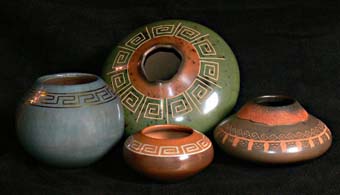
Lucho Soler
Non-Pueblo
Peru's museums hold some of the world's most beautiful examples of ancient ceramic work. You can find thousands of years worth of history molded into clay, allowing us to see through the eyes of the artists what was valued and worshiped by civilizations gone by.
The Chavin, Moche, Nazca, Wari, among so many more have let us know about their cultures with their beautiful representations of their daily lives and the environment that surrounded them.
The huge amounts of beautiful pottery displayed in the national museums and in history books inspired Lucho Soler, Lima-born artist, to jump into pottery, recognize it as a way of life and as part of himself.
Lucho Soler developed as an artist in his native Peru. He fell in love with pottery at age 10 when studying Peruvian history at school. He began making replicas of the pieces he admired from cultures spanning back over 3000 years of Peruvian history. By the time Lucho was a young adult in Lima, he was an accomplished potter, but his quest for knowledge and learning pushed him to leave his country to United States, where he discovered the celebrated native artists of the Pueblos in New Mexico. There he became familiar with the works of Maria Martinez and the many talented Native American Pueblo potters that produce some of the finest examples of ceramics in the world today. There Lucho lived and worked among some of the finest ceramicist, sharing ideas and, in some cases, working together to create unique and splendid creations.
After many years of continuing his exploration and research with clay, he has acquired the mastery to achieve the quality and beauty just like his ancestors. Lucho not only strives to challenge himself, even after 45 years of experience, to improve his skills and to push the clay just a little further, but he also shares his knowledge with others. He has been a professor at the famous Institute of American Indian Art School in Santa Fe, NM. In his native Peru he has taught countless workshops and given classes to young aspiring artists helping them learn about their cultural heritage and letting them find expression in creating something beautiful.
Lucho has returned to Peru to live and work. He has a private studio in Ollantaytambo, just outside of Cusco city, where he continues to produce his outstanding ceramic work. The clay that Lucho uses for his pieces, he digs out of the earth himself in the nearby hills. He does not use a wheel. The fine symmetry of the work he does is the result of hand-building using coils of clay carefully added one by one and then shaped using stones, paddles, and tools that Lucho has hand-made himself. The colors found in his pots are all naturally derived from clay and minerals mixed as slips.He does not use glazes, but instead employs the technique of stone polishing his work to produce a mirror-like shine that is completed before the firing process.He uses either his kiln that he built himself or fires his pieces in an outdoor wood or cow dung kiln. Finally, he hand carves his pots if he wishes to add more dimension to his work. The result is a perfectly unique work of art that reflects the ancient history of this amazing country and the passion of its creator.
Lucho's work has been in a number of art galleries throughout the U.S., the Peruvian Embassy in Paris, France, and at the Museo de la Nacion in Lima, Peru. He also had a show recently at Qoricancha (the Temple of the Sun) in Cusco, Peru. The exhibit consisted of all original works reflecting Lucho's vast knowledge of ceramics, Peruvian history, and his immense creativity and skill.
100 West San Francisco Street, Santa Fe, New Mexico 87501
(505) 986-1234 - www.andreafisherpottery.com - All Rights Reserved

Gonzales Family Tree
Disclaimer: This "family tree" is a best effort on our part to determine who the potters are in this family and arrange them in a generational order. The general information available is questionable so we have tried to show each of these diagrams to living members of each family to get their input and approval, too. This diagram is subject to change should we get better info.
-
Ramona Sanchez Gonzales (1885-), second wife of Juan Gonzales (painter)
- Blue Corn (Crucita Gonzales Calabaza)(1921-1999)(step-daughter of Ramona) & Santiago Calabaza (Santo Domingo) (d. 1972)
- Joseph Calabaza (Tha Mo Thay)
- Diane Calabaza-Jenkins (Heishi Flower) (1955-)
- Elliot Calabaza
- Oqwa Pi (Abel Sanchez)(1899-1971) & Tomasena Cata Sanchez (1903-1985)
- Skipped generation
- Russell Sanchez (1966-)
- Skipped generation
- Rose (Cata) Gonzales (daughter-in-law) (1900-1989) & Robert Gonzales (1900-1935)
- (Johnnie) Tse-Pe (Gonzales)(1940-2000) & Dora Tse-Pe (Gachupin, first wife, Zia, 1939-2022)
- Andrea Tse Pe (1975-)
- Candace Tse-Pe (1968-)
- Gerri Tse-Pe (1963-)
- Irene Tse-Pe (1961-)
- Jennifer Tse-Pe (1960-1977)
- (Johnnie) Tse-Pe (1940-2000) & Jennifer Tse Pe (Sisneros - second wife, Santa Clara)
- (Johnnie) Tse-Pe (Gonzales)(1940-2000) & Dora Tse-Pe (Gachupin, first wife, Zia, 1939-2022)
- Rose' students:
- Juanita Gonzales (1909-1988) & Louis "Wo-Peen" Gonzales (brother of Rose Gonzales husband)(1905-1992)
- Adelphia Martinez (1935-2022)
- Lorenzo Gonzales (1922-1995)(adopted by Louis & Juanita Gonzales) & Delores Naquayoma (Hopi/Winnebago)
- Jeanne M. Gonzales (1959-)
- John Gonzales (1955-)
- Laurencita Gonzales
- Linda Gonzales
- Marie Ann Gonzales
- Raymond Gonzales
- Robert Gonzales
- Juanita Gonzales (1909-1988) & Louis "Wo-Peen" Gonzales (brother of Rose Gonzales husband)(1905-1992)
Some of the above info is drawn from Pueblo Indian Pottery, 750 Artist Biographies, by Gregory Schaaf, © 2000, Center for Indigenous Arts & Studies. Other info is derived from personal contacts with family members and through interminable searches of the Internet.
(505) 986-1234 - www.andreafisherpottery.com - All Rights Reserved